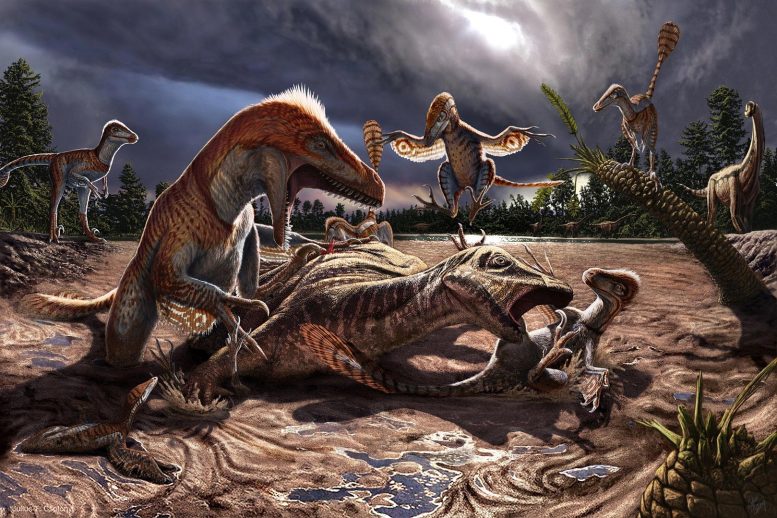
Csotonyi illustration: Portrayal of Utahraptors and prey trapped in quicksand deposit of the Stikes Quarry bone bed at Utahraptor Ridge. A recent geological study has discovered that the Utahraptor, the world’s largest “raptor” dinosaur, is 10 million years older than previously believed, now estimated to be at least 135 million years old. Credit: Julius Csotonyi, natural history illustrator
The Utahraptor, the world’s largest “raptor” dinosaur, is now estimated to be 135 million years old, 10 million years older than previously thought. The discovery has important implications for dinosaur evolutionary history and narrows the gap in the rock record between the Jurassic and Cretaceous Periods in Utah.
Utahraptor is going to need 10 million more candles on its next birthday cake.
A geological study of the rock formation that encased a fossilized example of the world’s biggest “raptor” shows it’s 10 million years older than previously understood. The report, co-written by a researcher with the University of Kansas, was recently published in the journal Geosciences.
“We determined the age of the dinosaur Utahraptor and found that it was much older than previously supposed,” said Gregory Ludvigson, emeritus senior scientist with the Kansas Geological Survey at KU, who collaborated on the investigation. “That finding has important implications for the evolutionary history of dinosaurs.”
The fieldwork took place in Utah at the well-known Utahraptor Ridge site, named for larger cousins of the ferocious velociraptor dinosaur (known to fans of “Jurassic Park”).
The ridge is home to Stikes Quarry, a fossil quicksand deposit packed with dinosaur fossils that are largely intact and preserved — in much the same positions as when they died. Stikes Quarry is part of the Cedar Mountain Formation, a rock unit containing fossils of more kinds of dinosaurs than any formation in the world.
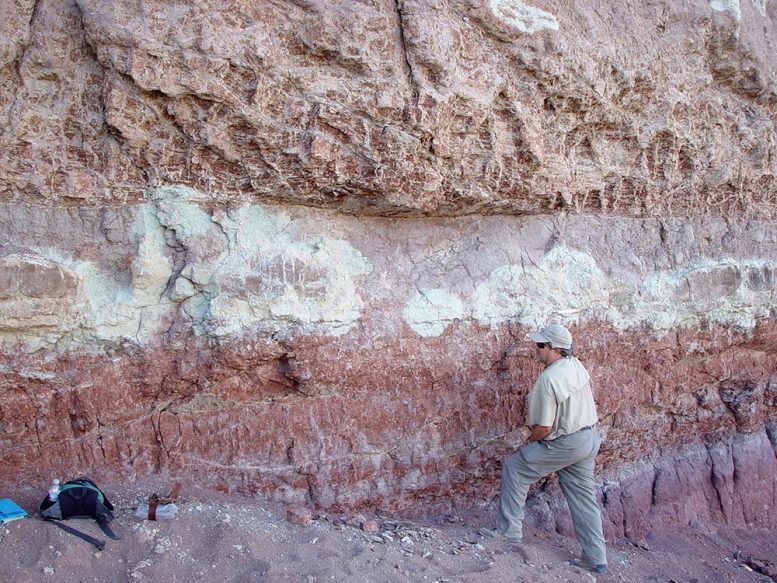
Greg Ludvigson on outcrop of colorful buried soils of the Yellow Cat Member in May 2009. Credit: Photo courtesy of Matt Joeckel
“We also learned to our complete surprise that the rock strata from the Stikes Dinosaur Quarry were deposited during a global change episode known as the Weissert Event,” Ludvigson said. “This is an agenda-setting discovery that will reverberate for decades.”
More than a decade ago, Ludvigson, along with Jim Kirkland, state paleontologist with the Utah Geological Survey, and Matt Joeckel, state geologist and director of the Conservation and Survey Division at the University of Nebraska-Lincoln, joined together to tackle that question.
The scientists and colleagues they recruited took two research approaches: One path — uranium/lead dating of zircon crystals — involved analyzing samples of these minerals collected at different depths in the rock layers. The second looked at changes in the relative abundance of two types of stable carbon isotopes found in buried organic matter.
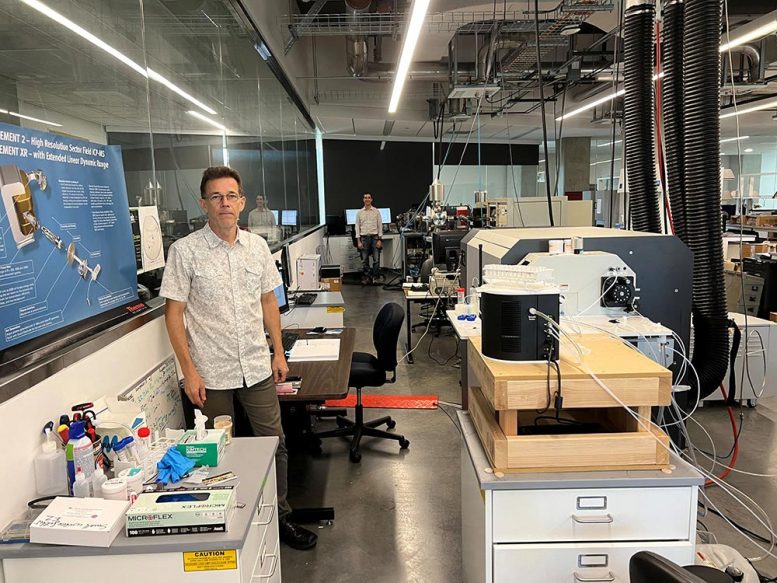
Andreas Möller and Noah McLean at the Isotope Geochemistry Laboratory in the KU Department of Geology. Credit: University of Kansas
By comparing results to periods in Earth’s history when global changes in the carbon cycle were known to have occurred, the team showed rocks in the Yellow Cat Member of the Cedar Mountain Formation — and the Utahraptor fossils found within — are 10 million years older than previously known.
Earlier estimates put the age of the rocks and fossils at 125 million years old.
“That’s a lot of evolutionary time,” Ludvigson said. “It’s kind of a vindication of something Jim’s argued for some time, but arguing doesn’t put an absolute age on it, and that’s important to him.”
The revised age indicates the rocks at the Stikes Quarry are at least 135 million years old. The lower part of the Yellow Cat Member encompasses even older strata. The findings narrow the gap in the rock record at the boundary between the Jurassic and Cretaceous Periods in Utah.
“Before, we had a 25-million-year gap between them,” said Kirkland, who first named and described the dinosaur Utahraptor ostrommaysi in 1993. “That’s a third of the age of mammals, more than double the length of time for hominid evolution. It’s a big chunk of time. Anything can happen over 25 million years if you have no record of what’s going on. We’ve plugged that record, for the most part.”
Reference: “Berriasian–Valanginian Geochronology and Carbon-Isotope Stratigraphy of the Yellow Cat Member, Cedar Mountain Formation, Eastern Utah, USA” by Robert M. Joeckel, Celina A. Suarez, Noah M. McLean, Andreas Möller, Gregory A. Ludvigson, Marina B. Suarez, James I. Kirkland, Joseph Andrew, Spencer Kiessling and Garrett A. Hatzell, 26 January 2023, Geosciences.
DOI: 10.3390/geosciences13020032
Additional co-authors are Celina Suarez, University of Arkansas; Noah McLean, Andreas Möller, Marina Suarez, Joseph Andrew and Spencer Kiessling, KU; and Garrett Hatzell, University of Arkansas.

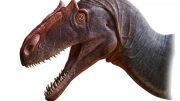
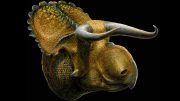
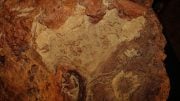
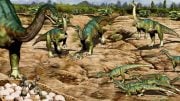

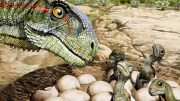
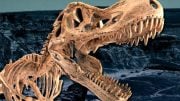
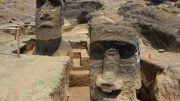
How is a bird a dinosaur the fact is dinosaur is a thecodont animal a gator animal .maniraptoran are birds they have kinesis skull like lizard that why basipterygoid process is different and laterosphenoid the archosaurmorph parietal is fuse to frontal which make the skull akinetic the archosaurmorph is not a thecodont it’s a protothecodont I did not check the other archosaurmorph the turtle the dinosaur fully occified laterosphenoid is firm fuse to frontal which make the skull akinetic .dinosaur skull is not as kinesis like lizard and bird allso there is early tetanuran with a kink snout that is not spinosauridae it’s not a megalosauridae too it has kink snout it’s the ancestor of tyrannosaur and megalosauridae. and spinosauridae is a tyrannosaur they are only 2 groups in tetanuran all about very hollow quadrate and other things gator has very hollow quadrate like t.rex megaraptor compsognathus types the bird quadrate foramen are for air sac that why they are big in birds and maniraptoran birds the dinosaur quadrate foramen are for blood vessel .this none spinosauridae kink snout there skull is very primitive the basisphenoid is not fuse to laterosphenoid a kinesis skull if they were fuse the skull will be akinetic like most dinosaur some bird hip dinosaur it’s not a firm fuse .thecodont mean crocodilian it mean crocodilian teeth unique to dinosaur and gator dinosaurmorph .maniraptoran is not a thecodont it’s true bird like how spinosauridae is true mesoeucrocodylia a fully form mesoeucrocodylia
Your grammar and punctuation is very strange. Is English a second language for you?
Too late for that I am allready internet star you do not need to become a great wiriter on forum .forum will never survive today.reason I am big star I read truth on the internet google scholar like anatomy and kinesis of allosaurus skull.I have evidence it’s free on internet science is all about evidence.other evidence a new armored dinosaur from the Cretaceous of Kansas.trigeminal nerve morphology in Wiley online library.on bird can see with out eyes like a gator dome pressure receptors or iso the bird name herbst corpuscles they are not the same or precurser to advance bird feature cliam by why evolution is true website .gator face is most sensoritive face out any animal number one on the finger it’s weaker like monkeys but not like humans only in the face it is better than humans those dome receptors has some thing to do with bipedalism it’s a lot on femur on the finger it is less on new finger it’s unique sensoritive system so claws can not grow that why loss 4th claws on toe for water sensory the 4th toe is use for walk in dinosaur not like the first toe it’s strange it’s missing a claw in gator this is on jeb iso as they call it.these sensory system are in mammal snake bird with different scientific name because they are different they say whisker are simular they are in bird wing feather beak and other places they mite be in confuciusornis I thought those fenestra on premaxillary were for the beak it mite be herbst corpuscles clearly it is for flight too .in dinosaur it’s in the mouth because they did not have feature for crushing bone only t.rex and gator have that .dinosaur was a serrated teeth hunter.in birds that live in cold places they do not have herbst on there legs interesting alligatoridae only have dome receptor on there head not like crocodile who have it all over there body .crocodile hate the cold only South Africa Nile crocodile like the cold so gator caiman came from cold places .on gator kinesis the akinetic gator has double head quadrate like today birds a streptostyly feature. dromaeosauridae one quadrate head like t.rex lack of flightless skull bird like archaeopteryx oviraptor has a double headed quadrate so kinesis was possible that what I hered prokinesis was possibly but modern bird kinesis was not possible I herd quadrate of oviraptor did not move like real dinosaur clearly utahraptor skull was akinetic .these early birds only show signs kinesis with fake laterosphenoid the laterosphenoid sopose to have a lot of names the evolution origin is different from birds mammal and reptiles I thought it was same bone till I read trigeminal nerve morphology. on researchgate archosauriformies laterosphenoid clearly badit scientist wrote that talk about archosaur not useing the name thecodont he said the bone is not found in turtle or lizard and never say birds. I thought same thing with basipterygoid process it’s a different bone in birds and reptiles I wrote about that allready.on archaeopteryx trigeminal face foramenfenestra 5th 7th archaeopteryx the foramen does not border the laterosphenoid because it’s small it’s not like tetanuran dinosaur and greatest dinosaur ever the gator .on troodon only found in laterosphenoid in tetanuran dinosaur gator archaeopteryx it’s on prootic .a primitive bipedal sauropod it’s simular to archaeopteryx or troodon I forgot which one clearly they are no dome receptors which was expected from primitive dinosaur i guest I final know won. only none tetanuran I know has it is ceratosaurus .protosuchus a none tetanuran gator ankle dinosaur allso lack dome receptors I only know that land crocodilian lack dome r I only know one land crocodilian with dome r but it’s mesoeucrocodylia which was expected .on none tetanuran gator ankle dinosaur one of them has 3 double head quadrate that more than the modern bird 1 quadrate head that what most thecodont have because there skull is akinetic.on to sapeornis it’s vomer is more primitive than archaeopteryx dromaeosauridae troodon it’s wide it has pygostyle tail .primitive animal sometimes has advance feature sapeornis is a primitive archaeopteryx it has hypocleidium furcula that means all maniraptoran oviraptor had won all there ancestor were flying bird that why microraptor has occified sternum clearly they are birds and not dinosaur this is on nature Cretaceous bird and pnas evolution of vomer.the modern bird neognathae vomer looks like troodon dromaeosauridae ichthyornis archaeopteryx.sapeornis probaly is very old some of flightless skull early bird have simular vomer like sapeornis the thin vomer is found in early bird utahraptor and modern neognathae bird.on gator new finger it’s smaller than other reptiles thinner too you can see nerve radia does not go to that 2 finger I notice that years ago from that link crocodilian behavior allso had fossil skin of dinosaur dome pressure receptors on there .
AI Artificial Irritation
All of this conjecture isn’t even best case scenario, it’s whatever the theoretical so-called expert want it to be. Constant changes in timelines and locations on the so-called tree, it’s like a house of cards built on a rickety table. This evolutionary train of thought can be manipulated to produce any sort of desired effect!